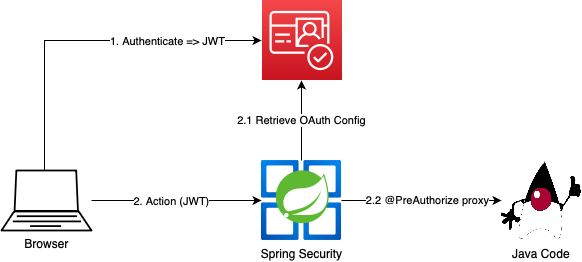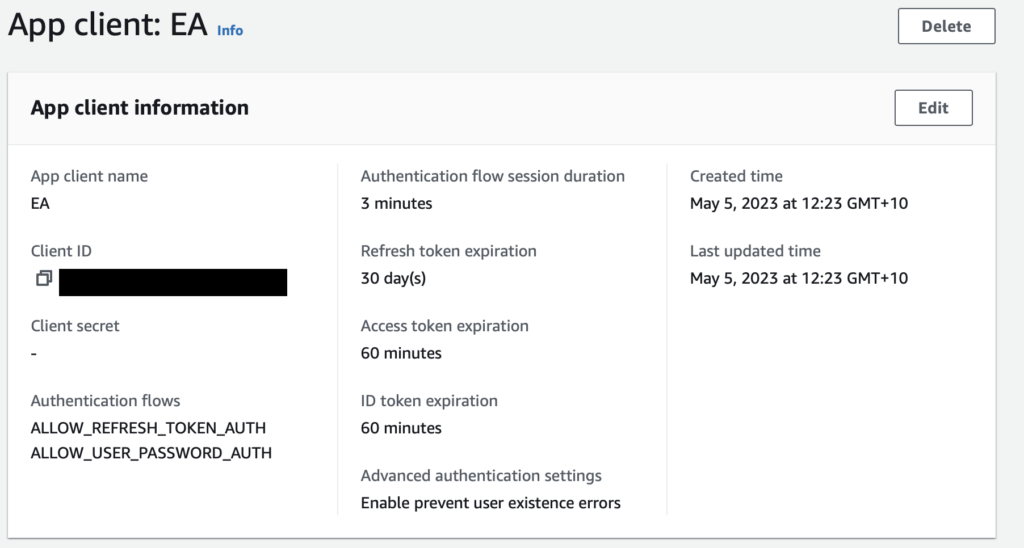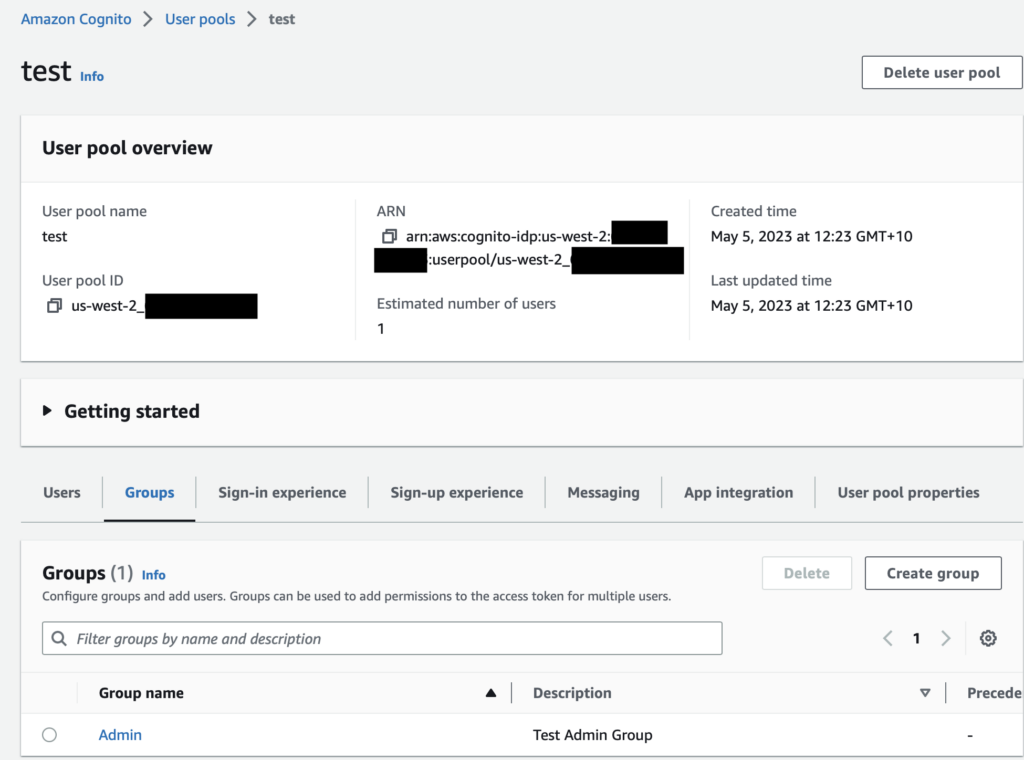How to integrate AWS Cognito and Spring Security using JSON Web Tokens (JWT), Cognito groups and mapping to Spring Security Roles. Annotations are used to secure Java methods.

AWS Cognito Configuration
- Configure a user pool.
- Apply a web client
- Create a user with a group.
The user pool can be created from the AWS web console. The User Pool represents a collection of users with attributes, for more information see the amazon documentation.
An app client should be created that can generate JWT tokens on authentication. An example client configuration is below, and can be created from the pool settings in the Amazon web console. This client uses a simple username/password flow to generate id, access and refresh tokens on a successful auth.
Note this form of client authentication flow is not recommended for production use.

We can now add a group so that we can bind new users to a group membership. This is added from the group tab on the user pool console.

Creating a user
We can easily create a user using the aws command line.
aws cognito-idp admin-create-user --user-pool-id us-west-2_XXXXXXXX --username hello aws cognito-idp admin-set-user-password --user-pool-id us-west-2_XXXXXXXX --username hello --password testtestTest1! --permanent aws cognito-idp admin-add-user-to-group --user-pool-id us-west-2_XXXXXXXX --username hello --group-name Admin
Fetching a JWT token
The curl example below will generate a token for our hello test user. Note that you will need to adjust the URL to the region your user pool is in, and the client id as required. The client ID can be retrieved from the App Client Information page in the AWS Cognito web console.
aws cognito-idp initiate-auth --auth-flow USER_PASSWORD_AUTH --client-id NOT_A_REAL_ID --auth-parameters USERNAME=hello,PASSWORD=testtestTest1!
Example access token
eyJraWQiOiJLeUhCMkYzNmRyc0QrNXdNT0x4NTJlQVNUNG5ZSmJTczB4NjJWT1pJNE9FPSIsImFsZyI6IlJTMjU2In0.eyJzdWIiOiJlODAwNGYyNy1lMGVjLTQ0YTMtOGRlZC0yYmE1M2UzOWZkZDMiLCJjb2duaXRvOmdyb3VwcyI6WyJBZG1pbiJdLCJpc3MiOiJodHRwczpcL1wvY29nbml0by1pZHAudXMtd2VzdC0yLmFtYXpvbmF3cy5jb21cL3VzLXdlc3QtMl82bkpHeGZKdkQiLCJjbGllbnRfaWQiOiJzZzRraTkyNDByNnBsMTlhdjRwYjA4N3JlIiwiZXZlbnRfaWQiOiIyZDM2MGQ1NS0yYjNiLTRlZjYtODM1ZC0xODZhYjE4ODAzZTMiLCJ0b2tlbl91c2UiOiJhY2Nlc3MiLCJzY29wZSI6ImF3cy5jb2duaXRvLnNpZ25pbi51c2VyLmFkbWluIiwiYXV0aF90aW1lIjoxNjg1ODc1MjY0LCJleHAiOjE2ODU4Nzg4NjQsImlhdCI6MTY4NTg3NTI2NCwianRpIjoiMWZhNTkyNzgtMGVhOC00N2E5LTg4OGYtMGJjNTQ4OWQwYzk4IiwidXNlcm5hbWUiOiJ0ZXN0In0.BZIH55ud1zCduw3WiMBbSlfEuVC4XPT6ND5CmhpbAqOI4_NghX-Y8ghW9FdIDch1bO0vDREChSEEKfPoWIe7MScsM3Gb6uhMjiE3cJBdquolY5T6JnFMS4JduREnGvlNXUx9H19DLV3zxauwciag6gSajGedGb8418T6X_qSiPgTOQqKS7J_WdodBtZ6k1_XCiTekFIc9WIkiRQdL6mo3yowSQJB4YJ7bCOrWquDkfCnoPvllbqCov7RGr8RUbGVmtZR14dm82RU_tu-AAdMDFshmVvYpfS5ZQProH97y05LlxDjJQ9t0TZwRcrfaMCAxfehfhBUViVNpr5DBgfcuA
If you decode the access token, you will see we have the claim cognito:groups set to an array containing the group Admin. See https://jwt.io
Spring Configuration
Our example uses Spring Boot 2.7x and the following maven dependencies:
<dependency>
<groupId>org.springframework.boot</groupId>
<artifactId>spring-boot-starter-oauth2-resource-server</artifactId>
</dependency>
<dependency>
<groupId>org.springframework.boot</groupId>
<artifactId>spring-boot-starter-security</artifactId>
</dependency>We start by configuring a Spring Security OAuth 2.0 Resource server. This resource server represents our service and will be guarded by the AWS Cognito access token. This JWT contains the cognito claims as configured in the Cognito User Pool.
This configuration is simply to point the issuer URL (JWT iss claim) to the Cognito Issuer URL for your User Pool.
spring:
security:
oauth2:
resourceserver:
jwt:
issuer-uri: https://cognito-idp.us-west-2.amazonaws.com/us-west-2_xxxxxxxxxThe following security configuration enables Spring Security method level authorisation using annotations, and configures the Resource Server to split the Cognito Groups claim into a set of roles that can be mapped by the Spring Security Framework.
This Spring Security configuration maps a default role, “USER” to all valid tokens, plus each of the group names in the JWT claim cognito:groups is mapped a a spring role of the same name. As per spring naming conventions, each role has the name prefixed with “ROLE_”. We also allow spring boot actuator in this example to function without any authentication, which gives us a health endpoint, etc. In production you will want to bar access to these URLs.
@Configuration
@EnableWebSecurity
@EnableGlobalMethodSecurity(prePostEnabled = true, securedEnabled = true, jsr250Enabled = true)
@Slf4j
public class SecurityConfig {
public static final String ROLE_USER = "ROLE_USER";
public static final String CLAIM_COGNITO_GROUPS = "cognito:groups";
@Bean
public SecurityFilterChain filterChain(HttpSecurity http) throws Exception {
return http
// actuator permit all
.authorizeRequests((authz) -> authz.antMatchers("/actuator/**")
.permitAll())
// configuration access is secured.
.authorizeRequests((authz) -> authz.anyRequest().authenticated())
// oauth authority conversion
.oauth2ResourceServer(this::oAuthRoleConversion)
.build();
}
private void oAuthRoleConversion(OAuth2ResourceServerConfigurer<HttpSecurity> oauth2) {
oauth2.jwt(this::jwtToGrantedAuthExtractor);
}
private void jwtToGrantedAuthExtractor(OAuth2ResourceServerConfigurer<HttpSecurity>.JwtConfigurer jwtConfigurer) {
jwtConfigurer.jwtAuthenticationConverter(grantedAuthoritiesExtractor());
}
private Converter<Jwt, ? extends AbstractAuthenticationToken> grantedAuthoritiesExtractor() {
JwtAuthenticationConverter converter = new JwtAuthenticationConverter();
converter.setJwtGrantedAuthoritiesConverter(this::userAuthoritiesMapper);
return converter;
}
@SuppressWarnings("unchecked")
private Collection<GrantedAuthority> userAuthoritiesMapper(Jwt jwt) {
return mapCognitoAuthorities((List<String>) jwt.getClaims().getOrDefault(CLAIM_COGNITO_GROUPS, Collections.<String>emptyList()));
}
private List<GrantedAuthority> mapCognitoAuthorities(List<String> groups) {
log.debug("Found cognito groups {}", groups);
List<GrantedAuthority> mapped = new ArrayList<>();
mapped.add(new SimpleGrantedAuthority(ROLE_USER));
groups.stream().map(role -> new SimpleGrantedAuthority("ROLE_" + role)).forEach(mapped::add);
log.debug("Roles: {}", mapped);
return mapped;
}
}A now a code example of the annotations used to secure a method. The method below, annotated by PreAuthorize, requires a group of Admin to be linked to the user calling the method. Note that the role “Admin” amps to the spring security role “ROLE_Admin” which will be sourced from the Cognito group membership of “Admin” as previously configured in our Cognito setup above.
@PreAuthorize("hasRole('Admin')")
@PostMapping
public Mono<JobInfo<TickDataLoadRequest>> create(@RequestBody TickDataLoadRequest tickDataLoadRequest) {
return client.getTickDataLoadClient().create(tickDataLoadRequest);
}That’s it! You now have a working example for configuring cognito and Spring Security to work together. As this is based on the Authorisation header with a bearer token, it will work with minimal configuration of API Gateway, Lambda, etc.

